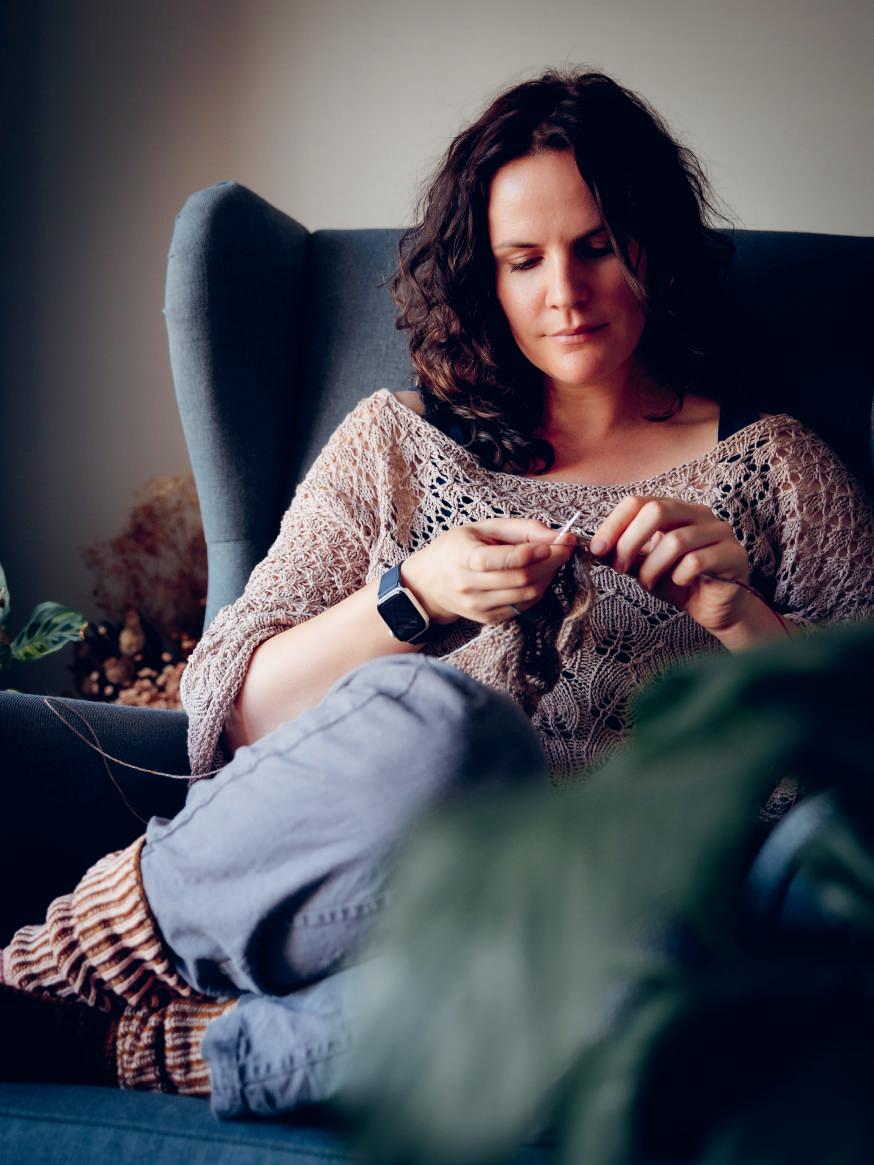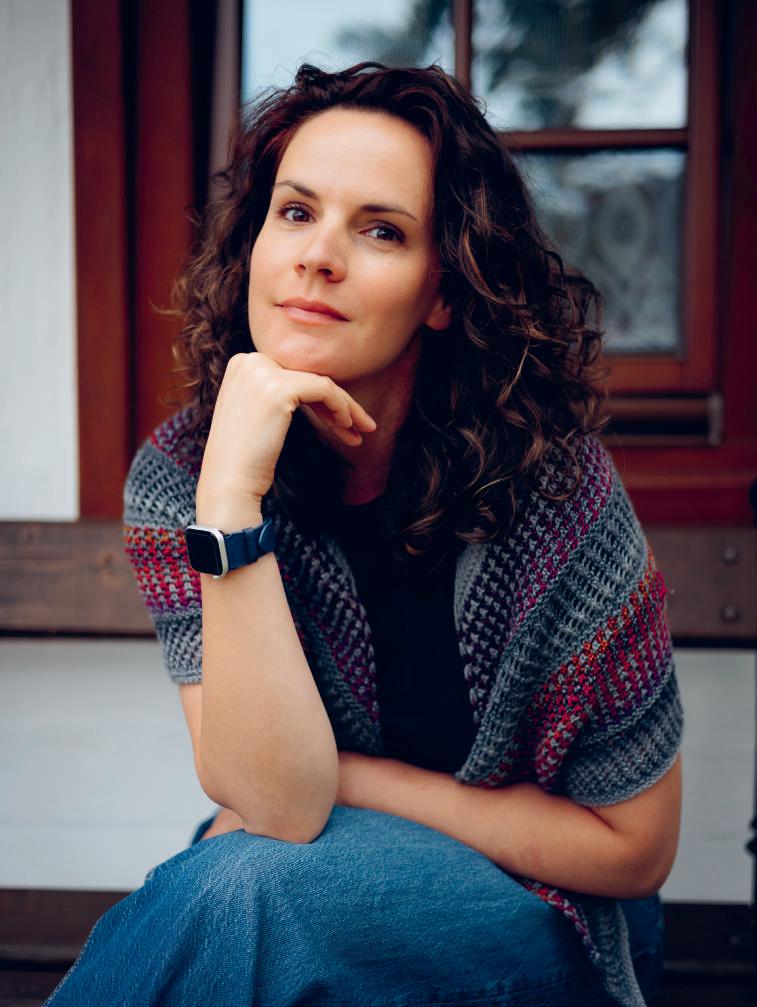
Joy in Every Stitch




For everyone who’s ever been told they’ve got two left hands.
Whoever said it was wrong.
All rights reserved.
No part of this book may be reproduced, stored in a retrieval system, or transmitted in any form or by any means — electronic, mechanical, photocopying, recording, or otherwise — without the prior written permission of the publisher.
The knitting patterns contained in this book are intended for personal, non-commercial use only and may not be used for profit or reproduced for resale without the author’s consent.
Copyright © Alžběta Lexová, 2025
Cover © Martin Stehlík, 2025
Photos © Alžběta Lexová, 2025
Czech Edition © Mystery Press, Praha 2025
ISBN 978-80-7588-996-6 (pdf)




It was one of those ordinary, forgettable days — the kind that feels like it couldn’t possibly matter, until you look back and realize a random, throwaway decision was actually a major turning point in your life. I don’t even remember how it really started. Not really. I was just mindlessly scrolling through Facebook one day when an event popped up: my college friend was opening a yarn shop in Prague.
A yarn shop? Wait, she knits? That had to be something she picked up after graduation. I couldn’t help flashing back to the two of us cramming for exams, convincing each other that the little we’d stuffed into our heads would surely be enough to get past this or that professor.
And, totally on a whim, I thought: why not? A purely whimsical decision. I’d stop by the store opening, say congrats, chat a little about the good old days. I had absolutely no plans to start knitting. My mom had tried to teach me when I was little, but in vain. She knit right-handed, and as a leftie my brain short-circuited instantly. The needles were soon thrown into the corner before I could accidentally poke someone’s eye out — most likely my own.
After that, I swore off crafts completely. Whenever it came up I'd joke that I had two left hands. So no, knitting was not part of the plan. But I still walked out of that Woolpoint opening with yarn and needles in hand, because my friend assured me that YouTube had leftie tutorials now, and I’d be fine.
Well… it wasn’t fine. Not really. But it was a little better, and this time around I was way more determined. One terrible swatch turned into one terrible project, which was quickly followed by another, and then — figuring that if I’d survived that, I could survive anything —
I jumped straight into colorwork. Before I knew it, knitting had taken root in my life for good.
To this day, my family shakes their heads in disbelief when they remember my childhood disasters with anything crafty. Especially my grandma — she still proudly displays a linocut fox of mine, convinced it’s a raccoon, which I quite literally paid for in blood.
The point of all this is twofold: first, even the tiniest, silliest decision can lead you somewhere completely unexpected. And second, if you once decided you “just don’t have the knack” for something, maybe it’s time to test that old belief again. I can’t promise you’ll suddenly turn into a master linocut artist, but you might discover you’ve been selling yourself short and missing out on something that could bring you a lot of joy.
So, if you’re just learning to knit, or you’re stubbornly picking it up for the third (or thirteenth) time and really don’t want to give up this time round (in which case: hats off to you, and keep going!), or if — like me — you already can’t imagine your life without knitting and this book just fell into your hands by chance, I hope it brings you as much delight as it has brought me. May you find joy in every single stitch.






Maybe some of these questions have crossed your mind. If so, you’ll find the answers here. (And if your mind is somewhere else entirely, feel free to turn the page.)
What Will i find in this book?
In the following pages you’ll discover ten patterns for all kinds of accessories large and small — some easy, some more challenging — for the head, the neck, the hands, and the feet. Playful projects where you can let your creative self run free, switch your brain off for a while, and relax. Whether you’re planning to knit for yourself or you’re ready to dive into gift-making for loved ones, I hope you’ll find just the right inspiration here.
hoW did these patterns come to be?
For most of them, the starting point was a color combination and a stitch pattern. As you’ll read in the introductions and see in the photos, nearly all were inspired by nature. Anyone who knows me from my social media knows my favorite design method is trial and error (if you didn't, now you do). Usually, there’s an idea at the beginning — one that quickly proves impossible — followed by another and another, until after many hours of work, math, and frogging, something finally emerges that I’m truly happy with.
As soon as you flip through the patterns, you’ll notice they all have one thing in common: they’re knit with hand-dyed yarn. Sometimes you can tell at first glance, sometimes the yarn looks ordinary — yet it never really is. Why hand-dyed yarn? Because it’s my favorite to knit with. Every skein is unique, full of love for the craft and for natural fibers, and has its own soul and story. With hand-dyed yarn, you can work wonders with your needles.
You can reach for bold skeins and create something almost modernist, pair one wild skein with another more subdued for balance, or choose steady colors and knit a quiet piece whose special quality only you will know.
Tip: If you’re choosing hand-dyed yarns and aren’t sure whether your skeins have enough contrast, try my secret trick: photograph them side by side, then switch the photo to black and white in your phone editor. You’ll see instantly whether the contrast is good (one skein will be noticeably darker than the other) or whether they both turn out a similar shade of gray — in which case, your finished contrast won’t be strong enough.
do i have to knit With hand-dyed yarns?
Not at all! I designed these patterns with my favorite brands, aiming to give each yarn or fiber the best chance to shine, but don’t let that hold you back. You can knit these pieces with anything that feels good in your hands. Each pattern includes suggestions for possible substitutions (though only ones I’ve personally worked with and can recommend with confidence). Of course, there are many, many more options out there.
can a beginner manage these patterns?
Each pattern comes with a little yarn scale of “difficulty” — one ball of yarn meaning “easy peasy”, as my friend would say, and five skeins meaning “utter nightmare”. Just kidding. (Sort of.)
No, seriously now. As I mentioned earlier, my third project ever was a hoodie with three-color stranded knitting. That’s why I believe beginners can tackle absolutely anything. All you need is courage and the patience to go stitch by stitch (worst case scenario, you’ll just rip it out). Patterns can look intimidating — so many abbreviations and seemingly illogical steps — but once you’ve got stitches on your needles, you’ll usually see what needs to be done.
does it matter that i’m not left-handed?
On the contrary — all the patterns were written (sorry, lefties) with right-handers in mind. But even as a left-hander, you’ll have no trouble knitting them. On page 77 you’ll find a few general tips for left-handed knitters, and in the patterns where it might cause issues, I’ve added notes on how to handle them.
If anything in the patterns is unclear, if you need help with a technique, or even just advice on choosing yarn, don’t hesitate to reach out. You’ll find me on Ravelry under the nickname babulale (don’t ask why… though I did reveal the story once in a podcast), on Facebook, Instagram, and also TikTok. You can also contact me through my website www.babuknitworks.com, our store, Woolpoint (www.woolpoint.cz), or via my wonderful publisher, Mystery Press (www.mysterypress.cz). I’ll be happy to help in any way I can!
If you’re just starting out, or coming back to knitting after a long break and feeling overwhelmed by the choice of yarns, tools, patterns, techniques, and the rest — don’t skip this chapter.
Knitting is not a demanding hobby. You don’t need protective gear, a weapon license, or night-vision goggles (though a little LED neck lamp can be handy in the evenings). What you do need is yarn and needles. yarn
When you walk into a yarn shop you’ll see there’s plenty to choose from. Wool, alpaca, silk, linen, mohair, all kinds of blends, and of course acrylic, the staple of our grandmas’ knitting baskets. If acrylic works for you (whether because of skin sensitivities or price), that’s perfectly fine — knit with what feels good in your hands. Personally, I avoid acrylic because it’s not breathable, not eco-friendly, and for me unpleasant both to knit with and to wear. I always reach for natural fibers — they glide through my fingers, they’re warm, they smell good; in short, they're simply a delight for all the senses.

Different materials suit different projects. In this book you’ll find sock and mitten patterns, both knit with yarn containing nylon for durability. Is it strictly necessary? Not at all. Just keep in mind that if you choose a fragile yarn (pure superwash merino, pure silk, alpaca) for something that takes a lot of wear, like socks or mittens, it won’t last very long. It also helps to think about which part of the body you’ll be wearing it on. The neck, for example, tends to be sensitive, so pick something soft (if you can’t stand mohair, you might like baby suri alpaca — or simply skip the “fluffy” yarns altogether and go with superwash merino). In principle, you can knit with anything — it’s just a question of how long (or whether) you’ll actually wear it, if at all.

You’ll notice that even in patterns not knit in the round, I list circular needles as the tool of choice. Why? Many people associate knitting with traditional straight needles, but those aren’t very practical. The weight of the project rests directly on them and you’re constantly shifting it from hand to hand, straining your wrists, shoulders, and tendons. Straight needles are also long and not very ergonomic, forcing you to hold your arms away from your body, which again isn’t good for your joints. Large projects won’t fit on them, and their rigidity can be unpleasant if you’re prone to carpal tunnel issues.
Circular needles, on the other hand, are both light and practical. The weight of the fabric rests on the cable, so you’re not lifting it with every movement. The tips are shorter, fitting comfortably in your hands, letting you keep your arms closer to your body. You can knit in the round or flat, fit all sorts of projects on them (depending on